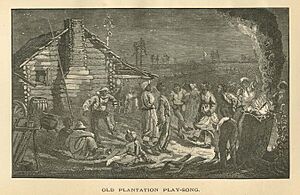Uncle Remus facts for kids
Quick facts for kids Uncle Remus |
|
|---|---|
 |
|
| First appearance | Uncle Remus, His Songs and His Sayings: The Folk-Lore of the Old Plantation |
| Created by | Joel Chandler Harris |
| Portrayed by | James Baskett (Song of the South) |
| Information | |
| Gender | Male |
| Nationality | African American |
Uncle Remus is a made-up character and storyteller from a collection of African American folktales. These stories were put together by Joel Chandler Harris and first published in a book in 1881. Harris was a journalist in Atlanta after the Civil War. He wrote seven books about Uncle Remus.
Harris wanted to share the experiences of African Americans, especially those who lived on plantations in the Southern United States. He did this by telling stories he had heard, setting them in a plantation world. He wrote these stories using a special way of writing words to show how people spoke in the Deep South at that time. Because of these choices, Harris's stories have been discussed and debated since they first came out.
Contents
The Stories and Characters
The Uncle Remus books are a group of animal stories, songs, and old tales from Black Americans in the South. Many of these stories teach a lesson, much like Aesop's Fables or Jean de La Fontaine's stories. Uncle Remus is a kind, older freedman who tells these folktales to children gathered around him. He is like a traditional African griot, who is a storyteller and historian.
The stories are written in a special way that tries to show how people spoke in the Deep South. Harris said he used this style to make the stories feel more real and true. Uncle Remus is a mix of different storytellers Harris met on the Turnwold Plantation. The stories are often about a "trickster" character. A trickster is someone who uses cleverness and tricks to get what they want.
Br'er Rabbit's Adventures
Br'er Rabbit ("Brother Rabbit") is the main character in the stories. He is known for being tricky and sometimes causing trouble. He often goes up against Br'er Fox and Br'er Bear.
In one famous story, Br'er Fox makes a doll out of tar and puts clothes on it. This is called the "tar baby". When Br'er Rabbit comes along, he talks nicely to the tar baby but gets no answer. Br'er Rabbit gets annoyed by what he thinks is the tar baby's bad manners. He punches and kicks it, and then he gets stuck!
Books by Joel Chandler Harris
Joel Chandler Harris wrote six Uncle Remus books between 1881 and 1907. After he passed away in 1908, three more books were published.
- Uncle Remus: His Songs and His Sayings (1881)
- Nights with Uncle Remus (1883)
- Uncle Remus and His Friends (1892)
- The Tar Baby and Other Rhymes of Uncle Remus (1904)
- Told by Uncle Remus: New Stories of the Old Plantation (1905)
- Uncle Remus and Brer Rabbit (1907)
- Uncle Remus and the Little Boy (1910)
- Uncle Remus Returns (1918)
- Seven Tales of Uncle Remus (1948)
Uncle Remus in Movies and TV
The Uncle Remus stories have been made into many films and TV shows.
Films
- Walt Disney's Song of the South (1946) was a movie that mixed live actors with cartoons. James Baskett played Uncle Remus.
- The Adventures of Brer Rabbit (2006) from Universal Animation Studios is a modern cartoon version of the stories. Nick Cannon was the voice of Br'er Rabbit.
TV Shows
- Rémusz bácsi meséi (1967) was a Hungarian TV series with 13 episodes.
- Jänis Vemmelsäären seikkailut (1987–1988) was a Finnish TV series with eight parts. It was shown as part of a children's show called Pikku Kakkonen.
- Brer Rabbit Tales (1991) was a TV film.
- Brer Rabbit's Christmas Carol (1992) was a follow-up film. It retold the story of Charles Dickens's A Christmas Carol using the Uncle Remus characters.
Uncle Remus in Music
Uncle Remus has also appeared in songs.
- In Bob Dylan's long poem "Last Thoughts on Woody Guthrie", he talks about people we often look to for hope. He says that "Uncle Remus can't tell you and neither can Santa Claus." This means that these characters can't give us all the answers.
- The song "Good Ole Boys Like Me" mentions Uncle Remus putting the singer to bed.


